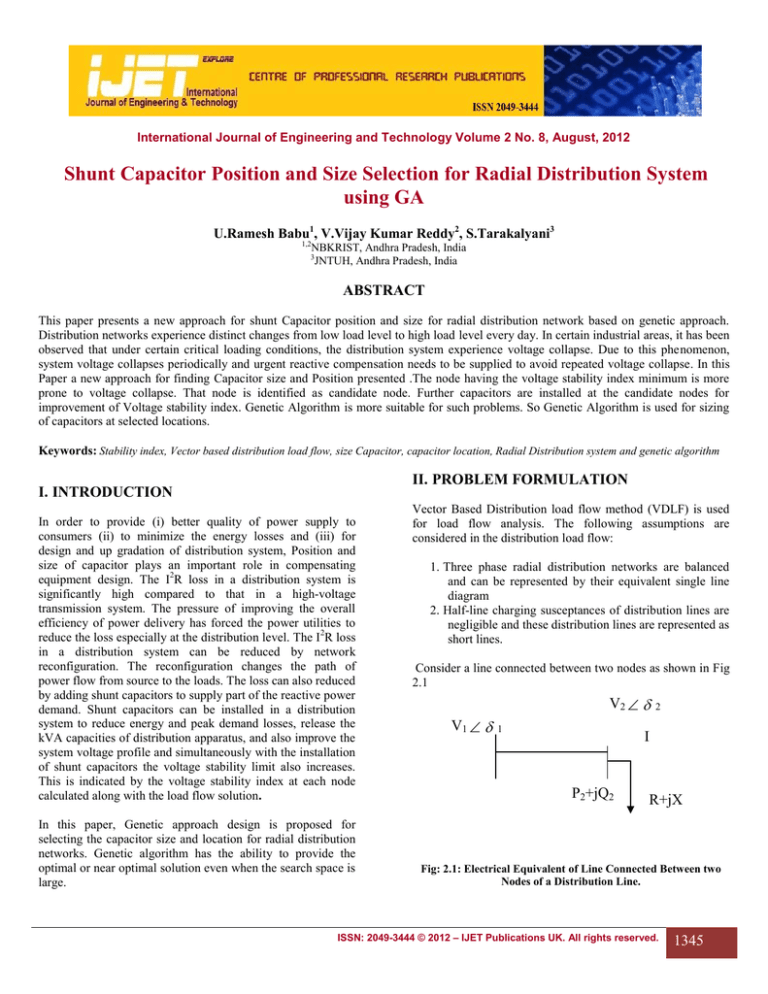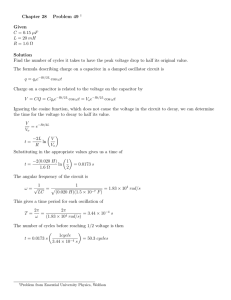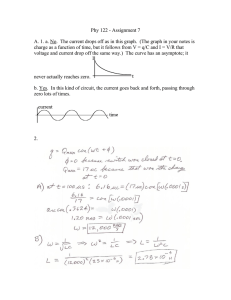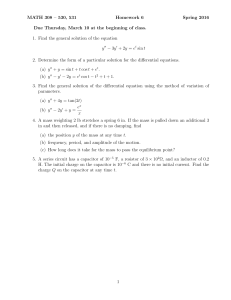
International Journal of Engineering and Technology Volume 2 No. 8, August, 2012
Shunt Capacitor Position and Size Selection for Radial Distribution System
using GA
U.Ramesh Babu1, V.Vijay Kumar Reddy2, S.Tarakalyani3
1,2
NBKRIST, Andhra Pradesh, India
JNTUH, Andhra Pradesh, India
3
ABSTRACT
This paper presents a new approach for shunt Capacitor position and size for radial distribution network based on genetic approach.
Distribution networks experience distinct changes from low load level to high load level every day. In certain industrial areas, it has been
observed that under certain critical loading conditions, the distribution system experience voltage collapse. Due to this phenomenon,
system voltage collapses periodically and urgent reactive compensation needs to be supplied to avoid repeated voltage collapse. In this
Paper a new approach for finding Capacitor size and Position presented .The node having the voltage stability index minimum is more
prone to voltage collapse. That node is identified as candidate node. Further capacitors are installed at the candidate nodes for
improvement of Voltage stability index. Genetic Algorithm is more suitable for such problems. So Genetic Algorithm is used for sizing
of capacitors at selected locations.
Keywords: Stability index, Vector based distribution load flow, size Capacitor, capacitor location, Radial Distribution system and genetic algorithm
II. PROBLEM FORMULATION
I. INTRODUCTION
In order to provide (i) better quality of power supply to
consumers (ii) to minimize the energy losses and (iii) for
design and up gradation of distribution system, Position and
size of capacitor plays an important role in compensating
equipment design. The I2R loss in a distribution system is
significantly high compared to that in a high-voltage
transmission system. The pressure of improving the overall
efficiency of power delivery has forced the power utilities to
reduce the loss especially at the distribution level. The I 2R loss
in a distribution system can be reduced by network
reconfiguration. The reconfiguration changes the path of
power flow from source to the loads. The loss can also reduced
by adding shunt capacitors to supply part of the reactive power
demand. Shunt capacitors can be installed in a distribution
system to reduce energy and peak demand losses, release the
kVA capacities of distribution apparatus, and also improve the
system voltage profile and simultaneously with the installation
of shunt capacitors the voltage stability limit also increases.
This is indicated by the voltage stability index at each node
calculated along with the load flow solution.
In this paper, Genetic approach design is proposed for
selecting the capacitor size and location for radial distribution
networks. Genetic algorithm has the ability to provide the
optimal or near optimal solution even when the search space is
large.
Vector Based Distribution load flow method (VDLF) is used
for load flow analysis. The following assumptions are
considered in the distribution load flow:
1. Three phase radial distribution networks are balanced
and can be represented by their equivalent single line
diagram
2. Half-line charging susceptances of distribution lines are
negligible and these distribution lines are represented as
short lines.
Consider a line connected between two nodes as shown in Fig
2.1
V2
V1
1
V2
P2+jQ2
2
I
R+jX
Fig: 2.1: Electrical Equivalent of Line Connected Between two
Nodes of a Distribution Line.
ISSN: 2049-3444 © 2012 – IJET Publications UK. All rights reserved.
1345
International Journal of Engineering and Technology (IJET) – Volume 2 No. 8, August, 2012
V2={[(P2R+Q2X-0.5V12)-(P22+Q22)
(R22+X22) ]1/2 + (P2R+Q2X-0.5V12)}1/2 ---2.6
The phasor diagram of this line
The equation 2.6 can be written in general form as
V2= (B[j]-A[j]) 1/2 -----2.7
where
subscript ‘2’ is the receiving end of j th branch.
subscript ‘1’ is the sending end of j th branch
Fig: 2.2 Basic Phasor Diagram of a Line Connected Between two
Nodes.
From fig 2.2 the following equations are derived
V12= (V2+Δx) 2+ Δy2 --------2.1
where Δx=IR cos (θ2) + IX sin (θ2) –2.2
A[j] = P2R[j] +Q2X[j]-0.5V12 ---2.8
(
R[j]2+X[j]2)]1/2
--2.9
Let Ploss[j] and Qloss[j] be the real and reactive power loss of
branch ‘j
B[j]
=
[A[j]2-
(P22+Q22)
Ploss[j] =R[j]* (P22+Q22)/V22
3.2
--
2.10
Qloss[j] =X[j]* (P22+Q22)/V22 -- 2.11
Δy=IX cos (θ2) - IR sin (θ2)—2.3
Using the equations 2.2 and 2.3 in 2.1 we have
Phase Angle Calculation
V12= (V2+ IR cos (θ2) + IX sin (θ2))2+ (IX cos (θ2) - IR
sin(θ2))2
I1=(V1 δ1-V2 δ2)/|Z| θ--- 2.12
V1= [(V2+ IR cos (θ2) + IX sin (θ2))2+ (IX cos (θ2)- IR sin
(θ2)2]1/2 -----2.4
2.13
from equations 3.12 and 3.13 we can write
P2effect+ Q2effect= V2 δ2 (V1 –δ1- V2 –δ2)/ |Z| -θ
= (V2 δ2 *V1 –δ1-V2 –δ2* V2 –δ2)/
|Z| -θ
=V2* V1 (δ2- δ1) - V2* V2 (δ2- δ2) /|Z| -θ
To eliminate I from the equation 2.4 use
I cos (θ2) = P2/ V2
I sin (θ2) = Q2/ V2
Where
P2=Total active power load including active power loss
beyond node 2.
Q2= Total reactive power load including reactive power loss
beyond node 2.
P2effect=V1* V2 cos (δ21+θ)/|Z|-V2cos (θ)/|Z|
Cos (δ21+θ) = (|Z|/ (V1V2))*[P2effect+ (V2 *V2) cos (θ)/|Z|] =
(|Z|/ (V1V2))*[P2effect+ (V2 /V1)*cos (θ)]
Let x= δ21+θy= (|Z|/ (V1V2))*[P2effect+ (V2 /V1)*cos (θ)]
Then x=cos-1(y)
x= δ2 -δ1+θ
herefore δ2=x+δ1-θ -----2.12
Thus Δx= IR cos (θ2) + IX sin (θ2)
= (P2R+Q2X)/V2
Δy= IX cos (θ2) - IR sin (θ2)
= (P2X-Q2R)/V2
III. GENETIC ALGORITHM
Thus equation 2.4 becomes
V12= (V2+ (P2R+Q2X)/V2)2+ ((P2X-Q2R)/V2)2
=V22+2V2(P2R+Q2X)/V2+
P2R+Q2X)2/V22+
2
2
2
2
4
Q2R) /V2 V1 V2 =V2 +(P2R+Q2X)2+2V22(P2R+Q2X)+
(P2X-Q2R)2V24+2 V22 (P2R+Q2X) + (P22+Q22)
( R22+X22) - V12 V22=0
V24+2 V22 (P2R+Q2X-V12/2) + (P22+Q22)
( R22+X22) =0 -------2.5
P2effect+ Q2effect= V2 δ2*I* ---
(P2X-
1. Read the system data.
2. Form idegree, itag, adjq & adjl vectors*.
3. Calculate effective load at each bus starting from the last
bus.
4. Initialize the population.
5. Set the iteration count to ‘1’.
6. Set chromosome count equal to ‘1’. (i.e. w=1)
7. Decode the chromosomes of the population and determine
the conductor number from the normalized form.
8. Run the load flow.
9. Calculate the objective function, given by Equation.
ISSN: 2049-3444 © 2012 – IJET Publications UK. All rights reserved.
1346
International Journal of Engineering and Technology (IJET) – Volume 2 No. 8, August, 2012
10. Calculate the fitness value of
the formula
the Chromosome, using
Fit[w]=1.0/(1+0.005*obj[w]);
Where w=chromosome count.
Table (1): Converged Voltages, Phase Angles and
Stability Index Values for 15-Bus system
Bus
Converged
Phase
Stability
No.
Voltages
Angles
Index
( in.p.u)
(Degrees)
1
1
0
1
2
0.97128
0.00065
0.88843
3
0.95667
0.00101
0.83723
4
0.9509
0.00115
0.81755
5
0.94992
0.0014
0.81422
6
0.95823
0.00386
0.84278
7
0.95601
0.00442
0.8353
8
0.95695
0.00418
0.83862
9
0.96797
0.00147
0.87789
10
0.9669
0.00173
0.87402
* Idegree vector indicates the number of lines connected
to each bus. itag vector indicates the reservation
allocated for each bus.
11
0.94995
0.00268
0.81426
12
0.94583
0.00372
0.80026
13
0.94452
0.00405
0.79586
adjq vector shows the adjacent bus number and adjl
vector shows the adjacent line number.
14
0.94861
0.00173
0.80973
15
0.94844
0.00177
0.80916
11. Repeat the procedure from step 7 for all chromosomes.
12. Sort the chromosomes and all their related data in the
descending order of fitness.
13. Calculate the error (Fit[1]-Fit[ps]).
14. Check if the error is less than 0.0001&check whether
voltage and current constraints are satisfied, if yes go to
19.
15. Now copy first 20% (i.e. % of elitism) of old population
chromosomes into the next population.
16. By applying Roulette-Wheel technique generate two off
springs. Then apply crossover and mutation operators
respectively on them.
17. Now replace old population with new population.
18. Increment iteration count. If iteration count Greater than
the max. Count, go to 6. Else goto 20.
19. Print the message “problem is converged”. Print the
Capacitor size, location and converged voltages.
20. Print the message “maximum number of iterations
have reached, yet the problem has not converged”.
IV. TEST CASE
Fig 4.2: Stability Index for 15 Bus System Before and after
Compensation
Fig 4.1: Single Line Diagram of 15 Bus System
ISSN: 2049-3444 © 2012 – IJET Publications UK. All rights reserved.
1347
International Journal of Engineering and Technology (IJET) – Volume 2 No. 8, August, 2012
Table (2): Capacitor Location and Size (in p. u.)
Using G A
Capacitor
Location
(Bus No.)
13
13
15
13
15
7
13
15
7
8
Capacitor
Size
(in p.u.)
4.125
4.125
5.1875
4.125
5.1875
2.9375
4.125
5.1875
2.9375
0.6875
Minimum
stability
index
achieved at
bus no.
15
Total Real
Power
Losses
(in p.u.)
7
0.40834
8
0.36413
14
0.36189
0.4938
[4] Kersting.W.H “A method to teach the design and
operation of a distribution system”IEEE Trans., Vol.
PAS-103, (1984), pp.1945-1952.
[5] Kersting W.H and Mendive D.L “An application of ladder
network theory to the solution of three phase radial
loadflow problem”IEEE PES winter meeting, Newyork,
January 1976, paper no A 76 044-8
[6] Renato C.G “New method for the analysis of distribution
networks”IEEE Trans. PWRD Vol.5, No.1 (1990),
pp.391-396.
[7] Jasmon G.B and Lee L.H.C.C “Stability of load flow
techniques for distribution system voltage Stability
analysis”IEE Proceedings. C. Vol.138, No.1, 1991, pp. 913.
[8] Brownell G, Clarke.H “Analysis and solutions for bulk
system voltage instability” IEEE Computer Applications
in Power, 1989,Vol.2, No.3, pp. 31-35.
REFERENCES
[1] M.Chakravorthy, D.Das “Voltage stability analysis of
radial distribution networks” International Journal of
Electric power and Energy systems 2001,vol.23, no.3,
pp.129-135.
[2] Das D, Kothari D.P, Kalam A“Simple and efficient
method for load flow solution of radial distribution
networks” International Journal of Electrical power and
Energy systems 1995,vol.17, no.5, pp.335-346.
[3] Mesult E.B, Wu F.F “Optimal capacitor placement on
radial distribution systems”IEEE Trans. on power
delivery, 1989, Vol.4, No.1, pp.725-734.
[9] Gubina F, Strmcnik B, “A simple approach to voltage
stability assessment in radial networks” IEEE Trans. on
power systems, 1997, Vol.12, No.3, pp. 1121-1128.
[10] Srinivasn sundarajan,Ail pahwa,”Optimal Selection of
Capacitors for Radial Distribution Systems using a
Genetic Algarithm”, IEEE Tranctions on power
systems,Vol.9,No.3,August 1994.pp 1499_1507
[11] M.H.Haque “Capacitor Placement in Radial distribution
systems
for
loss
reduction”,
IEEE
Proc,Generation,Transmission,Distribution,Vol.146 No.5
March 1999.pp 501_505.
[12] Mesut E. Baran ,Felix F.wu “OptimalmCaacitor
Placement on Radial Distribution systems”, IEEE
Transactions on Power Delivery, Vol. 4,No.1, January
1989.pp 725_734
ISSN: 2049-3444 © 2012 – IJET Publications UK. All rights reserved.
1348




